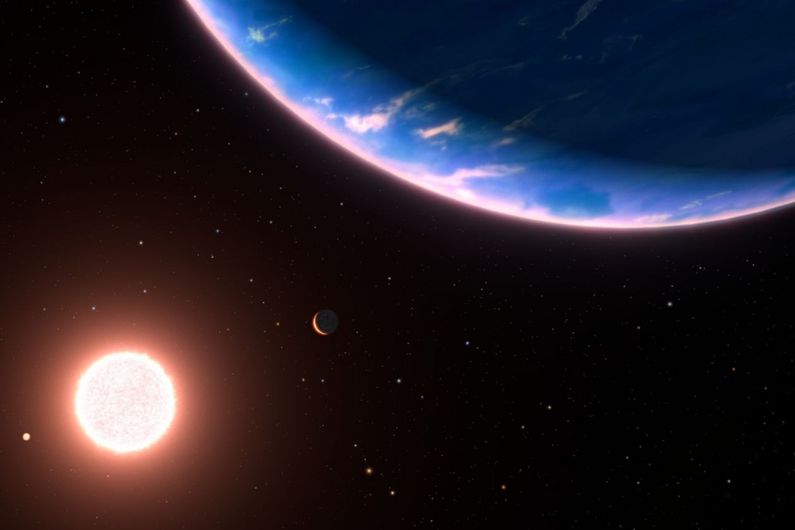Water vapour discovered in a small exoplanet’s atmosphere
- Salle de presse
01/25/2024
- UdeMNouvelles
With a diameter approximately twice that of Earth, GJ 9827d could be an example of a planet with a water-rich atmosphere, according to astronomers at UdeM.
A Canadian-led team of astronomers using NASA’s Hubble Space Telescope reports observing the smallest exoplanet to have water vapour detected in its atmosphere. At only approximately twice Earth’s diameter, the planet GJ 9827d could be an example of potential planets with water-rich atmospheres elsewhere in our galaxy.
Headed by scientists at Université de Montréal, the study was published last September in The Astrophysical Journal Letters.
“This would be the first time that we can directly show through an atmospheric detection that these planets with water-rich atmospheres can actually exist around other stars,” said co-author Björn Benneke of UdeM's Trottier Institute for Research on Exoplanets (iREx). “This is an important step toward determining the prevalence and diversity of atmospheres on rocky planets.”
Two plausible scenarios
It remains too early to tell whether Hubble spectroscopically measured a small amount of water vapour in a puffy hydrogen-rich atmosphere, or whether the planet’s atmosphere is mostly made of water, left behind after a primeval hydrogen/helium atmosphere evaporated under stellar radiation.
“Our observing program was designed specifically with the goal to not only detect molecules in the planet’s atmosphere, but to actually look specifically for water vapour," said the study’s lead author, Pierre-Alexis Roy, a doctoral student at iREx. "Either result would be exciting, whether water vapour is dominant or just a tiny species in a hydrogen-dominant atmosphere."
In the first scenario, the planet would still be clinging to a hydrogen-rich atmosphere laced with water, making it a mini-Neptune.
In the second, it would resemble a larger and hotter version of Europa, Jupiter’s moon, which has twice as much water under its crust as is found on Earth. In this case, said Benneke, “GJ 9827d could be half-water, half-rock: there would be a lot of water vapour on top of some smaller rocky body."
Smaller and smaller planets
“Until now, we had not been able to directly detect the atmosphere of such a small planet – and we’re slowly getting in this regime now,” added Benneke. “At some point, as we study smaller planets, there must be a transition where there’s no more hydrogen on these small worlds, and they have atmospheres more like Venus, which is dominated by carbon dioxide.”
Because GJ 9827d is as hot as Venus – around 430 degrees Celsius – it definitely would be an inhospitable, steamy world if its atmosphere were predominantly water vapour, the scientists say.
If the planet has a residual water-rich atmosphere, then it must have formed farther away from its host star, where the temperature is cold and water is available in the form of ice. In this scenario, the planet would have then migrated closer to its star and received more radiation; its hydrogen was heated and escaped or is still in the process of escaping the planet’s weak gravity.
In the other case, the planet would have formed close to the hot star and would have only a trace of water in its atmosphere.
Space telescopes on the case
The Hubble program observed the exoplanet during 11 transits – events in which the planet crossed in front of its star – spaced out over three years. During transits, starlight is filtered through the planet’s atmosphere and has the spectral fingerprint of water molecules. If there are clouds on the planet, they are low enough in the atmosphere to not completely hide Hubble’s view of the atmosphere, and so it can probe water vapour above the clouds.
This discovery opens the door to future study of these types of planets by the James Webb Space Telescope, which can see much more via infrared observation, including carbon-bearing molecules like carbon monoxide, carbon dioxide and methane. Once a total inventory of a planet’s elements is taken, comparisons can be made to its star.
GJ 9827d was discovered by NASA’s Kepler Space Telescope in 2017. It completes an orbit around a red dwarf star every 6.2 days. The star, GJ 9827, lies 97 light-years from Earth in the constellation Pisces.
About this study
"Water absorption in the transmission spectrum of the water world candidate GJ 9827 d," by Pierre-Alexis Roy et al., was published iSept. 12, 2023 n The Astrophysical Journal Letters on September 12, 2023.
Media contact
-
Marie-Ève Naud
Institut Trottier de recherche sur les exoplanètes (IREx)
Tel: 514-279-3222 -
Nathalie Ouellette
Institut Trottier de recherche sur les exoplanètes (iREx)
Tel: 613-531-1762 -
Jeff Heinrich
Université de Montréal
Tel: 514 343-7593













